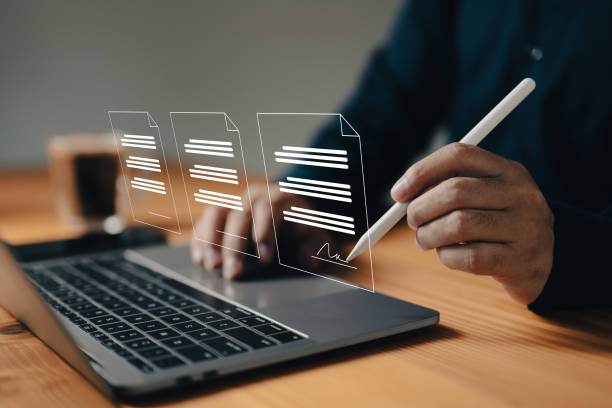What is On-Page SEO and Why is it Important?

On-Page SEO refers to a set of actions you take within your website to improve your site’s ranking in search engines like Google.
These actions include optimizing content, site structure, HTML tags, and other internal site elements.
Unlike Off-Page SEO, which refers to actions outside the site such as link building, On-Page SEO is completely under your control.
The importance of On-Page SEO lies in helping search engines better understand the topic and content of your pages, consequently ranking your site for relevant keywords.
With strong On-Page SEO, you can attract more organic traffic and ultimately achieve your business goals.
In this guide, we will comprehensively cover the techniques and strategies of On-Page SEO.
Improving site ranking in search results, increasing targeted traffic, enhancing user experience, and boosting conversion rates are among the key benefits of investing in On-Page SEO.
Learning SEO is essential for every online business owner.
Did you know that 94% of users’ first impressions of a business are related to its website design? With professional corporate website design by **RasaWeb**, turn this first impression into an opportunity for growth.
✅ Attract more customers and increase sales
✅ Build credibility and trust in the audience’s eyes⚡ Get a free website design consultation!
Keyword Research for On-Page SEO

Keyword research is the cornerstone of any successful SEO strategy.
Before anything else, you need to know what words your target audience enters into search engines.
Various tools are available for keyword research, including Ahrefs, Semrush, Moz Keyword Explorer, and Google Keyword Planner.
Using these tools, you can find keywords relevant to your business, analyze their search volume, and evaluate the level of competition.
After finding suitable keywords, you should strategically incorporate them into your content.
Using primary and secondary keywords in the page title, meta descriptions, headings and subheadings, main text, and image alternative text (alt text) can help improve your On-Page SEO.
Keep in mind that excessive use of keywords (keyword stuffing) can have a detrimental effect and lead to penalties from search engines.
Start On-Page SEO with proper research to achieve the best results.
Optimizing Page Title (Title Tag) and Meta Description

The Page Title (Title Tag) and Meta Description are two important elements in On-Page SEO that are displayed in search results.
The page title is the clickable title of your page that appears at the top of the browser tab and on the Search Engine Results Page (SERP).
The meta description is a brief summary of your page’s content that appears below the page title on the SERP.
Both of these elements should be attractive, relevant, and contain your primary keywords.
The page title should be a maximum of 60 characters and the meta description a maximum of 160 characters.
Using keywords in these two elements helps search engines better understand your page’s topic and increases the click-through rate (CTR).
For example, if your keyword is “buy sports shoes,” the page title could be “Buy Original Sports Shoes at the Best Price | Store …” and the meta description could be “Various men’s and women’s sports shoes from reputable brands with special discounts.
Shop now!”
These two elements play a crucial role in attracting users from the search results page to your site, and optimizing them is essential for On-Page SEO.
| Element | SEO Importance | Description |
|---|---|---|
| Page Title (Title Tag) | Very Important | Clickable page title in search results |
| Meta Description | Important | Short summary of page content in search results |
Optimizing URL Structure

Your site’s URL structure also plays an important role in On-Page SEO.
Clear, concise, and keyword-rich URLs help search engines better understand your page’s topic and show users what page they will be directed to by clicking the link.
A good URL should be descriptive, readable, and include the main keyword.
Avoid using special characters, excessive numbers, and uppercase letters in your URL.
For example, instead of “example.com/page123?id=456,” use “example.com/buy-sports-shoes”.
The URL structure should be hierarchical, making page access easy for users and search engines.
Using categories and subcategories in the URL can help improve your site structure and On-Page SEO.
Yoast SEO is a popular WordPress plugin for SEO optimization.
Is your e-commerce site ready to attract maximum customers and boost sales? RasaWeb transforms your online business with modern and efficient e-commerce website designs.
✅ Increase speed and improve SEO
✅ Excellent user experience on mobile and desktop⚡ Get a free e-commerce website design consultation from RasaWeb!
Content Optimization for Search Engines and Users

Content is the king of On-Page SEO.
High-quality, valuable, engaging, and user-relevant content can significantly boost your site’s ranking in search engines.
Optimize your content for primary and secondary keywords, but avoid excessive use of keywords.
Your content should be original and avoid copying others’ content.
Make your content readable and engaging by using headings, subheadings, lists, images, and videos.
Regularly update your content and publish new, relevant material.
On-Page SEO in content means providing the best answers to user questions in the form of engaging and valuable content.
To write SEO-optimized content, special attention must be paid to #keyword analysis, #audience targeting, #original content creation, and #visual element optimization.
Backlinko is a good resource for learning content SEO.
Image Optimization

Images play an important role in your site’s appeal and user experience.
However, unoptimized images can slow down your site’s loading speed and negatively impact your On-Page SEO.
To optimize images, use appropriate formats like JPEG for photos and PNG for graphic images.
Reduce image file sizes without compromising quality.
Use image compression tools like TinyPNG or ImageOptim.
For your images, choose descriptive file names that contain keywords.
For example, instead of “IMG_1234.jpg,” use “buy-men-sports-shoes.jpg.”
For each image, write appropriate and descriptive alternative text (alt text).
Alt text helps search engines understand the image’s topic and is displayed to users if the image fails to load.
On-Page SEO for images includes optimizing file names, alt text, and image size.
Page Speed Optimization

Site loading speed is a crucial factor in On-Page SEO and user experience.
Users expect your site’s pages to load quickly, and if the site is slow, they may abandon it.
Search engines also value site speed and rank faster sites higher.
To increase site speed, use a reputable and high-speed hosting provider.
Optimize your images.
Use a caching system.
Compress your HTML, CSS, and JavaScript code.
Use Content Delivery Networks (CDNs).
Tools like Google PageSpeed Insights and GTmetrix can help you measure your site’s speed and identify speed-related issues.
On-Page SEO with high speed satisfies users and pleases search engines.
| Factor | Description | Solution |
|---|---|---|
| Hosting | Choosing suitable hosting | Using quality and high-speed hosting |
| Image Size | Optimizing image size | Reducing image size without quality loss |
| Cache | Using a caching system | Activating a caching system for page storage |
Internal Linking

Internal linking means creating links between different pages within your own site.
Internal linking helps search engines better understand your site’s structure and helps users navigate your site easily.
Internal links should be relevant and descriptive.
Use appropriate anchor text (clickable link text) containing relevant keywords.
Internal linking helps distribute link juice throughout your site and can improve the ranking of your important pages in search engines.
A good On-Page SEO strategy would be incomplete without proper internal linking.
Are you tired of your e-commerce site having visitors but no sales? RasaWeb solves your core problem with professional e-commerce website designs!
✅ Significant sales increase with targeted design
✅ Flawless user experience for your customers
⚡ Get a free consultation!
Mobile Optimization

Given the increasing use of mobile devices for internet searches, optimizing your site for mobile is of particular importance.
Your site should be responsive, meaning it automatically adapts to different device screen sizes.
Mobile site loading speed should be high.
The site design should be simple and user-friendly, with easy access to various site elements on mobile.
Google uses Mobile-First Indexing, meaning it considers the mobile version of your site for ranking.
On-Page SEO for mobile is a necessity, not an option.
Using Schema Markup
![]()
Schema Markup is a code you can add to your site’s pages to provide search engines with more information about your page’s content.
Schema Markup helps search engines better understand your page’s topic and can lead to the display of rich snippets in the search results page.
Rich snippets can increase the click-through rate (CTR) and attract more traffic to your site.
There are various types of Schema Markup, including Schema Markup for articles, products, events, people, and organizations.
Using Schema Markup is an advanced On-Page SEO technique that can improve your site’s ranking in search engines.
Learning how to use Schema is essential for every SEO specialist.
On-Page SEO can boost your business.
Frequently Asked Questions
| Question | Answer |
|---|---|
| What is a Meta Title and why is it important in On-Page SEO? | The Meta Title is the most important On-Page SEO element displayed at the top of the browser tab and in search results. It helps search engines and users understand the main topic of the page and should include the primary keyword. |
| What role does the Meta Description play in On-Page SEO? | The Meta Description is a brief summary of the page’s content displayed below the title in search results. Although it doesn’t directly impact ranking, its appeal can increase the click-through rate (CTR). |
| How should keywords be used in page content? | Keywords should be used naturally and relevantly in strategic locations such as the title, headings, first paragraph, and body text. Avoid excessive keyword stuffing. |
| What is the importance of quality and comprehensive content in On-Page SEO? | High-quality, unique, informative, and comprehensive content that addresses user needs is of paramount importance. Search engines give higher rankings to content that provides real value. |
| What is the use of heading tags (H1-H6) in On-Page SEO structure? | Heading tags (H1, H2, H3, etc.) are used to structure content and indicate the importance of different sections. H1 is the main title of the page, and each page should have only one H1. Other tags are used for subheadings. |
| How can images be optimized to improve On-Page SEO? | To optimize images, use descriptive Alt Text that includes relevant keywords, reduce the image file size without compromising quality, and use meaningful and relevant file names. |
| What features does an SEO-friendly URL have for On-Page SEO? | An SEO-friendly URL should be short, readable, descriptive, include primary keywords, and be free of extra characters. The URL structure should be hierarchical and logical to be understandable for both users and search engines. |
| How does Internal Linking help On-Page SEO? | Internal linking helps users and search engine crawlers better understand the site structure by connecting related pages, transfers page authority, and increases user dwell time on the site. |
| What is the impact of page loading speed on On-Page SEO? | High loading speed is crucial for both user experience and SEO ranking. Slower pages may be overlooked by search engines and lead to an increased bounce rate. |
| Why is mobile-friendliness highly important in On-Page SEO? | Due to the increasing number of searches via mobile devices, having a responsive and mobile-friendly site is extremely essential for user experience and ranking in search results (Google’s Mobile-First Indexing). |
And other advertising agency services by Rasa Web in the field of advertising
- Smart Link Building: An innovative platform for improving customer behavior analysis using real data.
- Smart Custom Software: A combination of creativity and technology for analyzing customer behavior by optimizing key pages.
- Smart Conversion Rate Optimization: An effective tool for improving SEO ranking by optimizing key pages.
- Smart Data Analysis: A combination of creativity and technology for increasing sales by using real data.
- Smart Data Analysis: Transform online growth with the help of smart data analysis.
And over hundreds of other services in the field of internet advertising, advertising consulting, and organizational solutions
Internet Advertising | Advertising Strategy | Sponsored Content
Sources
- Comprehensive On-Page SEO Guide
- Complete On-Page SEO Tutorial
- What is On-Page SEO and Why is it Important?
- What is On-Page SEO and What is its Application?
? With RasaWeb Afarin, transform your business in the digital world! We pave the way for your online success by providing comprehensive digital marketing services, including corporate website design, SEO, and social media management. Shine with us and reach the peaks of your business.
📍 Tehran, Mirdamad Street, next to Central Bank, Southern Kazeroun Alley, Ramin Alley, No. 6




